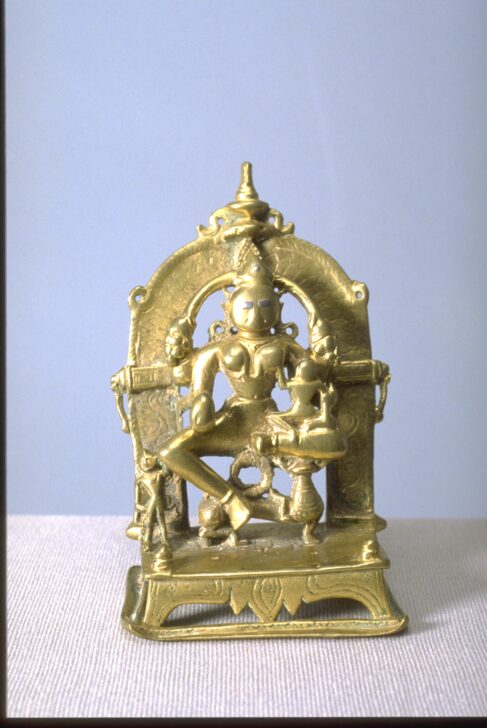Ambika
Indian

Description
March 28, 2009
An informal attitude distinguishes this figure’s seated posture from the meditation pose typically used to depict the twenty-four renunciant tirthankaras of the Jain faith. Indeed, she appears fully attached to worldly things: her front right hand holds a ripe oval mango while two rear arms reach up to pull more bundles of fruit hanging from branches. One child sits on her lap grasping her breast; a second child sits before her. She represents Ambika, the most popular of the nature spirits brought into the Jain pantheon as sasana-devatas (attendant–protectors) of the tirthankaras.
The sasana-devatas were beloved, and with good reason: tirthankaras—as perfected beings freed of worldly attachments—could not be approached to fulfill worldly desires. Less sublime divinities, on the other hand, could be visited by those seeking children, good marriage, financial success, or other good fortune. Associated with fertility, Ambika attracted devotees who wished to bear children, particularly male offspring like her own two sons.
(Label for UMMA South and Southeast Asia Gallery Opening Rotation, March 2009)
----
An informal attitude distinguishes this figure’s seated posture from the meditation pose typically used to depict the twenty-four renunciant tirthankaras (perfected beings) of the Jain faith. Indeed, she appears fully attached to worldly things: her front right hand holds a ripe oval mango while two rear arms reach up to pull more bundles of fruit hanging from branches. One child sits on her lap grasping her breast; a second child sits before her. She represents Ambika, the most popular of the indigenous nature spirits brought into the Jain pantheon as sasana-devatas (attendant–protectors) of the tirthankaras.
The sasana-devatas were beloved, and with good reason: as perfected beings freed of worldly attachments, tirthankaras could not be approached to fulfill worldly desires. Less sublime divinities, on the other hand, could be visited by those seeking children, good marriage, financial success, or other good fortune. Associated with fertility, Ambika attracted devotees who wished to bear children, particularly male offspring like her own two sons.
(South and Southeast Asia Gallery Rotation, Fall 2010)
Gallery Rotation Fall 2010
Ambika
India, Gujarat
17th century
Brass with silver inlay
Gift of Dr. and Mrs. Leo S. Figiel and Dr. and Mrs. Steven J. Figiel, 1975/2.114
An informal attitude distinguishes this figure’s seated posture from the meditation pose typically used to depict the twenty-four renunciant tirthankaras (perfected beings) of the Jain faith. Indeed, she appears fully attached to worldly things: her front right hand holds a ripe oval mango while two rear arms reach up to pull more bundles of fruit hanging from branches. One child sits on her lap grasping her breast; a second child sits before her. She represents Ambika, the most popular of the indigenous nature spirits brought into the Jain pantheon as sasana-devatas (attendant–protectors) of the tirthankaras.
The sasana-devatas were beloved, and with good reason: as perfected beings freed of worldly attachments, tirthankaras could not be approached to fulfill worldly desires. Less sublime divinities, on the other hand, could be visited by those seeking children, good marriage, financial success, or other good fortune. Associated with fertility, Ambika attracted devotees who wished to bear children, particularly male offspring like her own two sons.
Subject Matter:
Although the Jaina scriptures associate a particular god and goddess with each of the twenty-four jinas, in practice only a few of these deities are commonly depicted. Ambika, while properly associated with Nemi, the twenty-second jina, is the most popular of the goddesses, and in the Jaina context always appears with one or more children. This does reflect the concept of a universal mother goddess, which is found in many of the religions that developed in India and elsewhere.
The artist here uses little modeling for the figure, emphasizing instead her silhouette, with an almost two-dimensional effect. It is interesting to compare this very linear portrayal of a goddess with a similar approach found in paintings from the Kalpasutra, displayed nearby.
Physical Description:
Ambika sits above her stylized lion mount with a long body and with its tail curled to add support to the seated figure above. She sits with one leg pendant. She has four arms, the back two hold stylized mango clusters and her front right hand holds a large mango. Her left-hand cups a child seated on her left knee. Another child stands on the base to her right. The backing takes on a throne-like form, but she appears to float in front of it, the square-ish base is pierced and the arch of the back is surmounted by an auspicious pot form with leaves creating a volute shape to either side. The sculpture is solid brass, but the eyes and an ornament in her headdress are inlayed with silver.
Usage Rights:
If you are interested in using an image for a publication, please visit https://umma.umich.edu/request-image/ for more information and to fill out the online Image Rights and Reproductions Request Form.